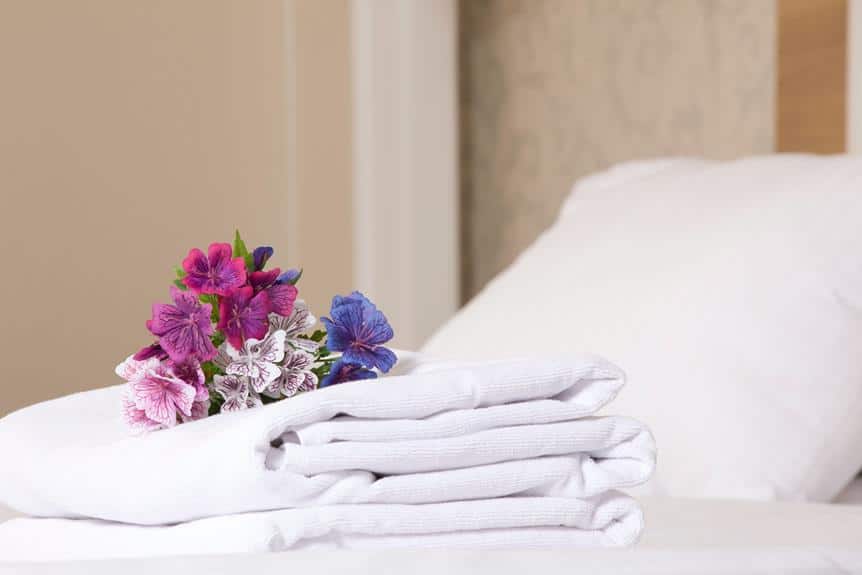To bleach white sheets and towels properly, follow these steps:
- Check the care labels to ensure they can be bleached.
- Dilute the bleach according to the manufacturer's instructions, considering the amount of laundry.
- Use the bleach solution to treat the sheets and towels, removing stains and disinfecting them.
This will help keep your white linens in good condition.
Understanding Bleach Types
When choosing a bleach for washing white sheets and towels, it's important to know the difference between chlorine bleach and color-safe bleach to prevent fabric damage.
Chlorine bleach is highly effective for whitening and disinfecting white linens but should be used carefully. Always check the care label on your linens to ensure they can be bleached.
If your linens are not bleach-safe, use color-safe bleach which has hydrogen peroxide as its main ingredient. It's gentler than chlorine bleach, safe for colored fabrics, and still whitens and sanitizes effectively when used in the right amount.
Always follow the instructions on the bleach container for proper dilution and soaking times to avoid damaging bleach-safe fabrics. Using the bleach dispenser in your washing machine helps apply bleach correctly during the wash cycle.
For a natural alternative, white vinegar can be used to brighten fabrics when combined with the right water temperature. However, for strong whitening results on bleach-safe fabrics, chlorine bleach is the best option if used carefully.
Preparing Your Laundry
Sort your white sheets and towels by color and fabric before bleaching. Check their care labels for bleach compatibility. Isolate them from colored laundry to avoid color transfer.
Use the correct amount of bleach in the dispenser, following the product's instructions for soaking time and dilution. Do not overload or underload the washing machine, and use the right amount of bleach-compatible laundry detergent.
Alternatively, for a natural cleaning solution, mix hot water with vinegar and baking soda, and pour it into the fabric softener compartment for whitening and deodorizing.
Always follow the care label instructions on your white linens to ensure their durability and cleanliness.
Mixing the Bleach Solution
To mix a chlorine bleach solution for whitening sheets and towels, combine 12 cups of bleach with 1 US quart of water using a measuring cup for accuracy. Too much or too little bleach can damage fabric or be ineffective. Always handle bleach with care, wearing gloves and working in a ventilated area. Don't pour bleach directly onto laundry; instead, add the diluted solution to your washing machine's bleach dispenser or into a large bucket for manual mixing.
For better results and to protect your fabrics, you can add a cup of baking soda to the wash. This keeps the pH level neutral and enhances cleaning. Use the correct amount of detergent for your load size.
For maximum effectiveness, do not overload the washing machine and use the highest hot water setting during the wash cycle to ensure even distribution of the bleach solution and free movement of the items being washed.
Bleaching Process Steps
- Add the bleach solution to the washing machine's bleach dispenser or a pre-soak bucket. Before using bleach, check the care label to ensure the fabric is bleach-safe. Measure the bleach according to the manufacturer's guidelines, matching the amount to the load size to prevent damage from overfilling the dispenser.
- Use liquid bleach suitable for the fabric. Pre-soak white items in the bleach solution for the duration specified on the care label to remove stains and body oils without causing yellowing or damage.
- After pre-soaking, place the items in the washing machine and run a regular wash cycle with the hottest water temperature safe for the fabric. For colored items that are bleach-safe, use a color-safe bleach alternative.
- Finally, rinse the items well after bleaching. Handled correctly, bleach will leave towels and bedding clean, white, and stain-free. Always use bleach with caution to preserve the quality of your linens.
Rinsing and Drying
After bleaching white sheets and towels, it's important to rinse them well to remove any remaining bleach, which could damage the fabric. A thorough rinse helps maintain the fabric's condition and extends its life. Use an extra rinse cycle on your washing machine with cold water, which is less harsh on textiles.
Before starting the rinse cycle, check that the washing machine dispenser is clear of bleach to prevent contamination. If the water looks cloudy or smells like bleach after the rinse, run another cycle.
Drying is also crucial; moisture can cause mildew, affecting the appearance and cleanliness of white linens. Dry sheets and towels completely, either in the sun for natural bleaching or in a tumble dryer on a low setting.
Proper rinsing and drying will keep your whites bright and long-lasting.
Maintenance and Care Tips
Using bleach in your laundry can help maintain the condition and brightness of white sheets and towels. To care for white linens, always check compatibility by reading both the linen and bleach labels. Avoid using too much bleach by following the product's instructions and measure carefully to prevent damaging fabrics.
For best results, wash white towels and sheets separately from colored items to avoid color transfer. Bleach not only whitens but also disinfects, removing mold, mildew, and graying from white fabrics. However, do not use bleach as the only cleaning agent. Regular washing with a white-specific detergent is advised, and use the highest temperature safe for the fabric as stated on the label.
Maintain your white linens by integrating these steps into your laundry process. Proper care and bleach use will keep your white sheets and towels bright and in good condition.





